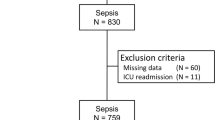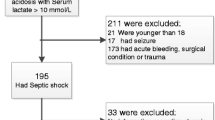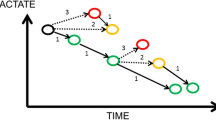Abstract
Objectives
In this study, changes in lactate clearance following magnesium supplementation were evaluated in critically ill patients with severe sepsis.
Methods
Fifty-eight patients with severe sepsis were randomly assigned to receive either magnesium (n = 30) or placebo (n = 28). Patients in the magnesium group received intravenous magnesium sulfate to maintain serum magnesium level around 3 mg/dL for 3 days. The placebo group received the same volume of normal saline. Change in lactate clearance was considered primary outcome of the study.
Results
Mean increase in the lactate clearance in the magnesium group was significantly higher than the placebo group on day 2 (27.53% vs. 23.79% respectively, p < 0.001) and day 3 (49.83% vs. 37.02% respectively, p < 0.001). Time to lactate clearance was also significantly shorter in the magnesium group than the placebo group (47.28 ± 20.59 vs. 61.20 ± 24.31 h respectively, p = 0.03). Sepsis-related mortality was not significantly different but median length of ICU stay was significantly shorter in the magnesium group than the placebo group (8 vs. 15 days respectively, p < 0.01).
Conclusions
Magnesium supplementation increased lactate clearance in critically ill patients with severe sepsis. Optimizing serum magnesium level near the upper limit of the normal range may improve severe sepsis outcomes.



Similar content being viewed by others
References
Panahi Y, Mojtahedzadeh M, Najafi A, Ghaini MR, Abdollahi M, Sharifzadeh M et al (2017) The role of magnesium sulfate in the intensive care unit. EXCLI J 16:464–482
Hansen B-A, Bruserud Ø (2018) Hypomagnesemia in critically ill patients. J Intensive Care 6(1):21
Fairley J, Glassford NJ, Zhang L, Bellomo R (2015) Magnesium status and magnesium therapy in critically ill patients: a systematic review. J Crit Care 30(6):1349–1358
Upala S, Jaruvongvanich V, Wijarnpreecha K, Sanguankeo A (2016) Hypomagnesemia and mortality in patients admitted to intensive care unit: a systematic review and meta-analysis. QJM 109(7):453–459
Kumar S, Honmode A, Jain S, Bhagat V (2015) Does magnesium matter in patients of medical intensive care unit: a study in rural Central India. Indian J Crit Care Med 19(7):379
Patel RK, Nair A (2018) Correlation of serum magnesium levels with clinical outcomes in critically ill patients admitted to medical ICU. PIJR7(8)
Velissaris D, Karamouzos V, Pierrakos C, Aretha D, Karanikolas M (2015) Hypomagnesemia in critically ill sepsis patients. J Clin Med Res 7(12):911–918
Moskowitz A, Lee J, Donnino MW, Mark R, Celi LA, Danziger J (2016) The association between admission magnesium concentrations and lactic acidosis in critical illness. J Intensive Care Med 31(3):187–192
Gupta S, Bindra G, Batada V, Gupta A (2016) To study serum magnesium level and its correlation with prognostic significance in critically ill patients. JIACM 17(1):37
Jiang P, Lv Q, Lai T, Xu F (2017) Does hypomagnesemia impact on the outcome of patients admitted to the intensive care unit? A systematic review and meta-analysis. Shock 47(3):288–295
Suetrong B, Walley KR (2016) Lactic acidosis in Sepsis: It's not all anaerobic: implications for diagnosis and management. CHEST 149(1):252–261
Kamble S, Patel H, Trivedi S (2017) Study of hypomagnesemia in critically-ill patients in medical intensive care unit at tertiary care hospital. JEBMH 4(67):4032–4036
Heidary Z, Khalili H, Mohammadi M, Beigmohammadi M-T, Abdollahi A (2018) Effect of magnesium loading dose on insulin resistance in patients with stress-induced hyperglycemia: a randomized clinical trial. J Intensive Care Med:0885066618777431
Taeb AM, Hooper MH, Marik PE (2017) Sepsis: current definition, pathophysiology, diagnosis, and management. Nutr Clin Pract 32(3):296–308
Lokhandwala S, Andersen LW, Nair S, Patel P, Cocchi MN, Donnino MW (2017) Absolute lactate value vs relative reduction as a predictor of mortality in severe sepsis and septic shock. J Crit Care 37:179–184
Giacalone M, Martinelli R, Abramo A, Rubino A, Pavoni V, Iacconi P et al (2015) Rapid reversal of severe lactic acidosis after thiamine administration in critically ill adults: a report of 3 cases. Nutr Clin Pract 30(1):104–110
Donnino MW, Carney E, Cocchi MN, Barbash I, Chase M, Joyce N et al (2010) Thiamine deficiency in critically ill patients with sepsis. J Crit Care 25(4):576–581
Londoño J, Niño C, Archila A, Valencia M, Cárdenas D, Perdomo M et al (2018) Antibiotics has more impact on mortality than other early goal-directed therapy components in patients with sepsis: An instrumental variable analysis. J Crit Care 48:191–197
Marty P, Roquilly A, Vallée F, Luzi A, Ferré F, Fourcade O et al (2013) Lactate clearance for death prediction in severe sepsis or septic shock patients during the first 24 hours in intensive care unit: an observational study. Ann Intensive Care 3(1):3
Shin J, Hwang SY, Jo IJ, Kim WY, Ryoo SM, Kang GH et al (2018) Prognostic value of the lactate/albumin ratio for predicting 28-day mortality in critically ILL Sepsis patients. Shock 50(5):545–550
Dellinger RP, Levy MM, Rhodes A, Annane D, Gerlach H, Opal SM et al (2013) Surviving Sepsis campaign: international guidelines for management of severe sepsis and septic shock, 2012. Intensive Care Med 39(2):165–228
Walther L, Winnefeld K, Sölch O (2000) Determination of iron, copper, zinc, magnesium and selenium in plasma and erythrocytes in neurosurgical patients. J Trace Elem Med Biol 14(2):92–95
Dawson JB, Heaton EW (1961) The determination of magnesium in biological materials by atomic absorption spectrophotometry. Biochem J 80:100–106
García R, Báez A (2012) Atomic absorption spectrometry (AAS); InTech: Published online at www.intechopen.com.
Bernstein WK, Aduen J, Bhaliani A, Kerzner R, Davison L, Miller C et al (1994) Simultaneous arterial and venous lactate determinations in critically ill patients. Crit Care Med 22(1):A228
Baig MA, Shahzad H, Hussain E, Mian A (2017) Validating a point of care lactate meter in adult patients with sepsis presenting to the emergency department of a tertiary care hospital of a low-to middle-income country. World J Emerg Med 8(3):184
Woolum JA, Abner EL, Kelly A, Bastin MLT, Morris PE, Flannery AH (2018) Effect of thiamine administration on lactate clearance and mortality in patients with septic shock. Crit Care Med 46(11):1747–1752
Lee SM, Kim SE, Kim EB, Jeong HJ, Son YK, An WS (2015) Lactate clearance and vasopressor seem to be predictors for mortality in severe sepsis patients with lactic acidosis supplementing sodium bicarbonate: a retrospective analysis. PLoS One 10(12):e0145181
Didwania A, Miller J, Kassel D, Jackson EV, Chernow B (1997) Effect of intravenous lactated Ringer's solution infusion on the circulating lactate concentration: part 3. Results of a prospective, randomized, double-blind, placebo-controlled trial. Crit Care Med 25(11):1851–1854
Boysen SR, Dorval P (2014) Effects of rapid intravenous 100% L-isomer lactated Ringer's administration on plasma lactate concentrations in healthy dogs. J Vet Emerg Crit Care (San Antonio) 24(5):571–577
Andrews B, Semler MW, Muchemwa L, Kelly P, Lakhi S, Heimburger DC et al (2017) Effect of an early resuscitation protocol on in-hospital mortality among adults with sepsis and hypotension: a randomized clinical trial. JAMA 318(13):1233–1240
Hernandez G, Bellomo R, Bakker J (2018) The ten pitfalls of lactate clearance in sepsis. Intensive Care Med. 2019; 1;45(1):82–85
Elenjickal N, Lakra D (2017) Study of serum magnesium levels in critically ill patients. JEMDS 6(42):3332–3336
Miyamoto K, Nakashima T, Shima N, Kato S, Ueda K, Kawazoe Y et al (2018) Effect of dexmedetomidine on lactate clearance in patients with septic shock: a subanalysis of a multicenter randomized controlled trial. Shock 50(2):162–166
Ding X-F, Yang Z-Y, Xu Z-T, Li L-F, Yuan B, Guo L-N et al (2018) Early goal directed and lactate-guided therapy in adult patients with severe sepsis and septic shock: a meta-analysis of randomized controlled trials. J Transl Med 16(1):331
Acknowledgments
Office of Vice-Chancellor for Research of Tehran University of Medical Sciences, Tehran, Iran, supported this work. We thank the general ICU nursing staff of Imam Khomeini Hospital for their kind support.
Author information
Authors and Affiliations
Contributions
Afsaneh Noormandi: Data gathering, data analysis, manuscript drafting
Hossein Khalili: Designing of study, data analysis, interpretation of results, final editing of manuscript
Mostafa Mohammadi: Patients’ selection, clinical interpretation of data
Alireza Abdollahi: Laboratory analysis
Corresponding author
Ethics declarations
Conflict of interest
The authors declare that they have no conflict of interest.
Additional information
Publisher’s note
Springer Nature remains neutral with regard to jurisdictional claims in published maps and institutional affiliations.
Rights and permissions
About this article
Cite this article
Noormandi, A., Khalili, H., Mohammadi, M. et al. Effect of magnesium supplementation on lactate clearance in critically ill patients with severe sepsis: a randomized clinical trial. Eur J Clin Pharmacol 76, 175–184 (2020). https://doi.org/10.1007/s00228-019-02788-w
Received:
Accepted:
Published:
Issue Date:
DOI: https://doi.org/10.1007/s00228-019-02788-w




